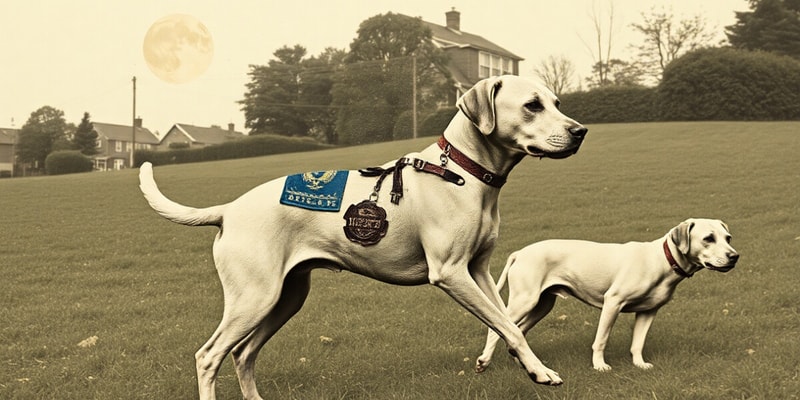Podcast
Questions and Answers
What is a key factor to consider when choosing a leash for your dog?
What is a key factor to consider when choosing a leash for your dog?
Which command is essential to teach your dog for better control during walks?
Which command is essential to teach your dog for better control during walks?
How should you handle the leash during walks?
How should you handle the leash during walks?
What should you do when there are unleashed dogs in your vicinity?
What should you do when there are unleashed dogs in your vicinity?
Signup and view all the answers
Which item is essential to carry during walks for your dog's health?
Which item is essential to carry during walks for your dog's health?
Signup and view all the answers
During what type of weather should you avoid walking your dog?
During what type of weather should you avoid walking your dog?
Signup and view all the answers
How can you manage your dog's behavior during walks when they show anxiety?
How can you manage your dog's behavior during walks when they show anxiety?
Signup and view all the answers
What is a recommended strategy for adding variety to your dog's walks?
What is a recommended strategy for adding variety to your dog's walks?
Signup and view all the answers
Study Notes
Safety Precautions
- Always supervise your dog closely during walks, especially in unfamiliar environments.
- Be aware of potential hazards such as traffic, other animals, and dangerous terrain.
- Use a leash appropriate for your dog's size and strength.
- Ensure the leash is securely fastened and that it doesn't pose a strangulation risk.
- Keep the leash loose enough to allow your dog to move freely but tight enough to control them.
- Never walk your dog alone in a high-traffic area where they could run into danger.
- Avoid walking your dog during peak hours of traffic if possible.
- Be cautious of unleashed dogs and keep your dog on a leash in areas where they are prevalent.
Equipment Considerations
- Invest in a sturdy, well-fitting harness or collar and a leash that's sturdy and appropriate for your dog's size.
- Ensure your leash is long enough to allow your dog to explore but short enough to maintain control.
- Choose reflective gear for both you and your dog, particularly when walking at night or in low-light conditions.
- Carry waste bags and dispose of pet waste responsibly.
- Pack water, especially during hot weather walks.
Training and Behavior Management
- Teach your dog basic commands such as "heel," "stay," and "come."
- Practice these commands frequently in controlled environments.
- Reward desired behaviors with positive reinforcement, such as treats or praise.
- Correct unwanted behaviours with gentle but firm corrections to prevent pulling or running off.
- Be patient and consistent in your training.
- Recognize and address any anxiety or aggression your dog may display during walks.
- Desensitise and counter-condition your dog to potential triggers if they are causing anxiety.
- Consult a veterinarian or certified dog trainer if your dog exhibits extreme fear or aggression.
- Develop a routine that incorporates regular walks into your dog's schedule.
- Understand your dog's breed and physical limitations.
Considerations for Specific Situations
- Consider the weather conditions when planning a walk.
- Avoid walking during extreme heat or cold.
- Vary your walks – introduce new routes and locations and use different surfaces.
- Choose dog-friendly parks and trails with wide spaces and suitable surfaces for your dog.
- If walking on a paved or hard surface, consider dog booties to protect paw pads.
- Be prepared for unforeseen circumstances, like encountering other dogs or wildlife.
- Learn to identify and understand your dog's body language to prevent problems.
- Adjust your walking pace to match your dog's energy levels.
Studying That Suits You
Use AI to generate personalized quizzes and flashcards to suit your learning preferences.
Description
This quiz covers essential safety precautions and equipment considerations for walking your dog. Learn how to supervise your dog, manage potential hazards, and choose the right gear to ensure a safe walking experience. Test your knowledge and keep your dog safe in various environments.




